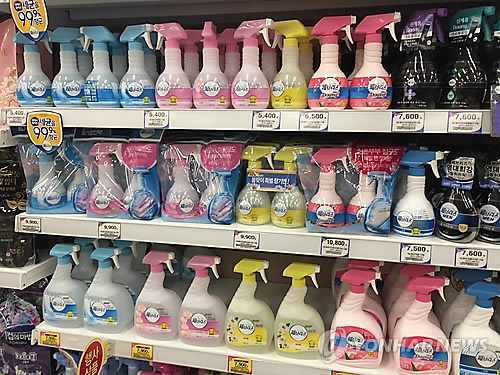Consumers, companies press gov't for guidelines on household chemicals
By KH디지털2Published : May 18, 2016 - 13:50
Demand is growing from the public and corporations for the government to set a definitive guideline and regulations on household chemicals as fear deepens over their untested toxicity.
The government on Tuesday announced that air and fabric freshener brand Febreze, manufactured by P&G Korea, is safe to use.

Consumers alarmed by the death-causing biocides in humidifier disinfectants had raised suspicions about the brand, forcing the environment ministry to hurriedly screen it for health hazards. It said the level of benzisothiazolinone (BIT) and didecyldimethylammonium chloride (DDAC), the two agents in Febreze products that had raised worries, are not harmful.
The problem, corporate officials and consumer groups say, is that government announcements fail at calming the scare. Fabric softeners, air fresheners and dehumidifiers, all common household goods, contain antiseptics and preservatives, but they are categorized as industrial goods, which leaves their ingredient labeling more difficult for consumers to decipher, unlike cosmetics-related products.
That the government has no definitive answers on if and how skin contact or inhalation of different biocides affect the human body also adds to the scare, critics say.
Many see similarities between now and what happened in 2013 when wet tissues were suspected of including dangerous chemicals. A consumer advocacy group had said that wet tissues being sold in the country contained the same agents used in humidifier sterilizers. The claim was made after mysterious deaths from lung complications were linked to humidifier sterilizers for the first time in 2011.
The agents -- chloromethyl-isothiazolone (CMIT) and methylisothiazolone (MIT) -- had been approved by the Ministry of Food and Drug Safety as preservatives in industrial goods, but
consumers were unconvinced of their safety after the nearly 100 deaths that by that time were blamed on the humidifier sterilizers.
The ministry in 2015 said that the amount of 28 preservatives used in wet tissues did not pose health risks, but the scare continued, with sales of the products halving. Manufacturers were forced to change the ingredients.
"We substituted the MIT with other preservatives that have been approved by the government, but we worry that even this will not do," an official at one of the companies manufacturing wet tissues said. "Because the product is moist, it has to have preservatives. The most important point here is that the government needs to rigorously monitor the level of use."
An official at another company said CMIT/MIT are more purified forms of preservatives than other chemicals, including the previous phenoxyethanol that is still being used in Japan.
"The problem arises when the chemicals are used excessively to extend shelf life. Just containing a negligible level of the chemicals doesn't make wet tissues a toxic product," this official said. "What will allay public fears is the government establishing a reliable supervisory system and cracking down on products that are in violation." (Yonhap)







![[KH Explains] How should Korea adjust its trade defenses against Chinese EVs?](http://res.heraldm.com/phpwas/restmb_idxmake.php?idx=644&simg=/content/image/2024/04/15/20240415050562_0.jpg&u=20240415144419)










![[Today’s K-pop] Stray Kids to return soon: report](http://res.heraldm.com/phpwas/restmb_idxmake.php?idx=642&simg=/content/image/2024/04/16/20240416050713_0.jpg&u=)